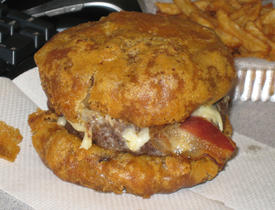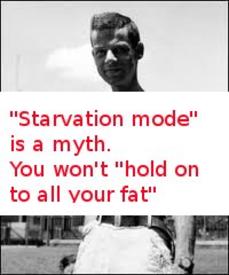Fruit Sugar
Options

LexieDouglas92
Posts: 20 Member
Morning,
I am trying to eat a lot more fruits and vegetables and eat a loss less meat - since doing this, I have found I go over my sugar allowance every day by a substantial amount because of the fruit.
Is this something I should be worried about as its only natural sugar?
Thanks
I am trying to eat a lot more fruits and vegetables and eat a loss less meat - since doing this, I have found I go over my sugar allowance every day by a substantial amount because of the fruit.
Is this something I should be worried about as its only natural sugar?
Thanks
0
Replies
-
"natural" sugar is still sugar, so it isn't like it doesn't count just because you got it from an apple.
However, unless you have a reason to be concerned with tracking sugar, like diabetes or something, then going over on sugar is no big deal. As long as you are keeping a caloric deficit you will lose weight no matter how much sugar you eat.0 -
Your body has no real way of discerning the difference between 'fruit sugar' and others. Barring a specific medical issue, don't worry about sugar at all.0
-
Looking at your diary it isn't really "fruit" that's doing it - over 1/3 of the sugar one days was from some "vitamin water" (see below) and anothe rlarge contribution from a fruit soya yoghurt which I guess is also laced with sugar.
Dragonfruit flavoured Vitamin Water Ingredients :-
Spring Water, Fructose, Sugar, Citric Acid, Vitamins (C, Niacin, E, Pantothenic Acid, B6, Folic Acid), Sweetener (Steviol Glycosides), Mineral Salt (Ferric Pyrophosphate), Colour (Anthocyanins), Natural Flavourings0 -
Fruits and Veggies are so good for you! I go over every day on sugar because of fruit and I ignore it because I know I"m eating well. Think of all the nutrition you're getting!0
-
Looking at your diary it isn't really "fruit" that's doing it - over 1/3 of the sugar one days was from some "vitamin water" (see below) and anothe rlarge contribution from a fruit soya yoghurt which I guess is also laced with sugar.
Dragonfruit flavoured Vitamin Water Ingredients :-
Spring Water, Fructose, Sugar, Citric Acid, Vitamins (C, Niacin, E, Pantothenic Acid, B6, Folic Acid), Sweetener (Steviol Glycosides), Mineral Salt (Ferric Pyrophosphate), Colour (Anthocyanins), Natural Flavourings
This for sure0 -
GauchoMark wrote: »"natural" sugar is still sugar, so it isn't like it doesn't count just because you got it from an apple.
However, unless you have a reason to be concerned with tracking sugar, like diabetes or something, then going over on sugar is no big deal. As long as you are keeping a caloric deficit you will lose weight no matter how much sugar you eat.
This is so good to know!! I was worried because I go over on sugars all the bloody time! So happy to read this. Thank you!
Thank you!
0 -
Fruits are not bad, unless you have a disorder/disease that requires carb/sugar management. I stopped tracking it because it was driving me nuts to be "over", even when the sugar was coming from grapes or an apple.
Echoing above as well. Gotta watch out for those flavored waters though! They're mostly sugar water. Better off drinking a real glass with some fruit slices infused in it!0 -
It bothers me that I can't flag a post for being helpful or insightful -- well done, yarwell!
For others lured here by the headline -- if you're not sensitive to sugar, it's hard to eat too much sugar per ounce/gram of whole fruits (exception: dried fruits and maybe grapes). Eating too much fruit sugar will make it harder to balance your calories toward the proteins and fats column.
However, refined sugars are very dense -- a lot of calories for their light weight -- and when eaten to excess can cause short-term unwanted mental and physiological changes (a sugar high, an unusually blood-sugar spike) and long-term changes such as diabetes and lipid reactions.0 -
0
-
I've just changed my calorie tracker so I see fibre instead of sugar - problem fixed
 0
0 -
THIS!RllyGudTweetr wrote: »Your body has no real way of discerning the difference between 'fruit sugar' and others. Barring a specific medical issue, don't worry about sugar at all.
All sugar is sugar - whether from a fruit or from candy! IT don't matter, your body treats it the same.
Unless you got tha diiiiaabeeettuuus, you're good to go!
Now excuse me while I go finish my tub of candy for breakfast!
-1 -
Ask your doctor.
Mine approved all the fruit I want to eat. 0
0 -
Why are we reducing protein??0
-
Thank you so much for getting back to me = all good to know! yes Vitamin water was a massive shock once I had finished it, but if you look at the past week has mostly been dates/grapes etc. but thanks for all the advice0
-
No, not all sugar is treated the same. There is evidence that fructose (a sugar in fruit but also a prominent sugar in High Fructose Corn Syrup as well as prominent in table sugar) is metabolized differently, converting more quickly to fat than expected.
http://well.blogs.nytimes.com/2008/07/24/does-fructose-make-you-fatter/
Again, the small amount of sugar in a whole fruit is not concerning for most people. It's the high concentration of sugar in processed foods, baked products, syrups, and etc. that create for high-sugar meals and out-of-balance diets.0 -
LexieDouglas92 wrote: »Morning,
I am trying to eat a lot more fruits and vegetables and eat a loss less meat - since doing this, I have found I go over my sugar allowance every day by a substantial amount because of the fruit.
Is this something I should be worried about as its only natural sugar?
Thanks
Speak with your doctor, know one knows better than him.
Not sure why you would want to reduce your protein... Do you find your hungry all the time? that's because your not eating enough protein.
0 -
OP - sugar is sugar ..does not matter where it comes from. I would suggest not tracking it at all. As long as you are in a calorie deficit you will lose weight. So focus on being in your calorie and macro goals for the day, and not so much about sugar.0
-
No, not all sugar is treated the same. There is evidence that fructose (a sugar in fruit but also the sugar in High Fructose Corn Syrup) is metabolized differently, converting more quickly to fat than expected.
http://well.blogs.nytimes.com/2008/07/24/does-fructose-make-you-fatter/
Again, the small amount of sugar in a whole fruit is not concerning for most people. It's the high concentration of sugar in processed foods, baked products, syrups, and etc. that create for high-sugar meals and out-of-balance diets.
a NY times blog is hardly a definitive source....0 -
Tedebearduff wrote: »LexieDouglas92 wrote: »Morning,
I am trying to eat a lot more fruits and vegetables and eat a loss less meat - since doing this, I have found I go over my sugar allowance every day by a substantial amount because of the fruit.
Is this something I should be worried about as its only natural sugar?
Thanks
Speak with your doctor, know one knows better than him.
Not sure why you would want to reduce your protein... Do you find your hungry all the time? that's because your not eating enough protein.
Hi, I am trying to cut down meat not for a health point of view but for other reasons 0
0 -
No, not all sugar is treated the same. There is evidence that fructose (a sugar in fruit but also the sugar in High Fructose Corn Syrup) is metabolized differently, converting more quickly to fat than expected.
http://well.blogs.nytimes.com/2008/07/24/does-fructose-make-you-fatter/
Huge sample size
http://www.ncbi.nlm.nih.gov/pmc/articles/PMC2546703/
0 -
LexieDouglas92 wrote: »
Hi, I am trying to cut down meat not for a health point of view but for other reasons
When in a deficit, its pretty important to get protein to help maintain muscle mass. If you don't eat meat there are tons of other ways to get it.0 -
Six whole subjects. Huge indeed.No, not all sugar is treated the same. There is evidence that fructose (a sugar in fruit but also the sugar in High Fructose Corn Syrup) is metabolized differently, converting more quickly to fat than expected.
http://well.blogs.nytimes.com/2008/07/24/does-fructose-make-you-fatter/
Huge sample size
http://www.ncbi.nlm.nih.gov/pmc/articles/PMC2546703/
0 -
Sarcasm is a great thing! Acg67's posts typically have it!
I will point out that fruit sugar (aka fructose) IS processed differently. However, the evidence that it is going to make you fatter is not really there. Here is a good summary from an interesting article:
http://www.bodyrecomposition.com/an-objective-comparison-of-chocolate-milk-and-surge-recovery/Carbohydrate
Surge has dextrose (synonymous with glucose) as its sole carbohydrate source, while chocolate milk has an even mix of sucrose (in the form of either sucrose or high-fructose corn syrup) and lactose. While it’s common to assume that dextrose is superior to sucrose for postexercise glycogen resynthesis, research doesn’t necessarily agree. A trial by Bowtell et al showed a glucose polymer to synthesize more glycogen by the 2-hr mark postworkout [14]. However, two other trials whose postexercise observation periods were 4 and 6 hours respectively saw no significant difference in glycogen storage between sucrose and glucose [15,16].
Perhaps the most overlooked advantage of a fructose-containing carbohydrate source (sucrose is 50% fructose) is that it supports liver glycogen better than a glucose-only source, as in the case of Surge. A little-known fact is that hepatic glycogenolysis (liver glycogen use) occurs to a significant degree during exercise, and the magnitude of glycogenolysis is intensity-dependent [17]. Illustrating the potential superiority of sucrose over glucose, Casey et al saw no difference in muscle glycogen resynthesis 4 hrs postexercise [15]. However, there was more liver glycogen resynthesis in the sucrose group, and this correlated with a slightly greater exercise capacity.
One of the potential concerns of consuming a large amount of sucrose instead of glucose is how the 50% fructose content in sucrose might be metabolized from a lipogenic standpoint. Answering this question directly, McDevitt saw no difference in de novo lipogenesis (conversion to fat) between the massive overfeeding of either glucose or sucrose at 135g above maintenance needs [18]. Another potential concern is the use of high-fructose corn syrup (HFCS) in chocolate milk. The common fear of HFCS being some sort of special agent that undermines health is simply not grounded in science. HFCS is virtually identical to sucrose both in chemical structure and metabolic effect [19]. Independent researcher John White eloquently clarified HFCS misconceptions in a recent review, which I’ll quote [20].
“Although examples of pure fructose causing metabolic upset at high concentrations abound, especially when fed as the sole carbohydrate source, there is no evidence that the common fructose-glucose sweeteners do the same. Thus, studies using extreme carbohydrate diets may be useful for probing biochemical pathways, but they have no relevance to the human diet or to current consumption. I conclude that the HFCS-obesity hypothesis is supported neither in the United States nor worldwide.”0 -
I have found it much more useful to check the Glycemic load of foods and beverages than going strictly by sugar grams here at MFP. Proteins, fiber and fats help to balance the rate insulin releases into your bloodstream.
Minimizing insulin spikes throughout your life can aid in type 2 diabetes prevention later in life. Most whole fruits and most vegetables are just fine GL wise, so no need to heavily restrict those items.
Juices and dried fruits are concentrated, and should be limited. Example to make 12 ounces of orange juice it takes 6 medium oranges. That is a ton of sugar, and you have removed almost all of the fiber. Not many people could or would eat 6 oranges in a sitting, but its easy to drink.0 -
I actually caught the sarcasm; I was highlighting a relevant bit for the "TL;DR" folks.GauchoMark wrote: »Sarcasm is a great thing! Acg67's posts typically have it!
I will point out that fruit sugar (aka fructose) IS processed differently. However, the evidence that it is going to make you fatter is not really there. Here is a good summary from an interesting article:
http://www.bodyrecomposition.com/an-objective-comparison-of-chocolate-milk-and-surge-recovery/Carbohydrate
Surge has dextrose (synonymous with glucose) as its sole carbohydrate source, while chocolate milk has an even mix of sucrose (in the form of either sucrose or high-fructose corn syrup) and lactose. While it’s common to assume that dextrose is superior to sucrose for postexercise glycogen resynthesis, research doesn’t necessarily agree. A trial by Bowtell et al showed a glucose polymer to synthesize more glycogen by the 2-hr mark postworkout [14]. However, two other trials whose postexercise observation periods were 4 and 6 hours respectively saw no significant difference in glycogen storage between sucrose and glucose [15,16].
Perhaps the most overlooked advantage of a fructose-containing carbohydrate source (sucrose is 50% fructose) is that it supports liver glycogen better than a glucose-only source, as in the case of Surge. A little-known fact is that hepatic glycogenolysis (liver glycogen use) occurs to a significant degree during exercise, and the magnitude of glycogenolysis is intensity-dependent [17]. Illustrating the potential superiority of sucrose over glucose, Casey et al saw no difference in muscle glycogen resynthesis 4 hrs postexercise [15]. However, there was more liver glycogen resynthesis in the sucrose group, and this correlated with a slightly greater exercise capacity.
One of the potential concerns of consuming a large amount of sucrose instead of glucose is how the 50% fructose content in sucrose might be metabolized from a lipogenic standpoint. Answering this question directly, McDevitt saw no difference in de novo lipogenesis (conversion to fat) between the massive overfeeding of either glucose or sucrose at 135g above maintenance needs [18]. Another potential concern is the use of high-fructose corn syrup (HFCS) in chocolate milk. The common fear of HFCS being some sort of special agent that undermines health is simply not grounded in science. HFCS is virtually identical to sucrose both in chemical structure and metabolic effect [19]. Independent researcher John White eloquently clarified HFCS misconceptions in a recent review, which I’ll quote [20].
“Although examples of pure fructose causing metabolic upset at high concentrations abound, especially when fed as the sole carbohydrate source, there is no evidence that the common fructose-glucose sweeteners do the same. Thus, studies using extreme carbohydrate diets may be useful for probing biochemical pathways, but they have no relevance to the human diet or to current consumption. I conclude that the HFCS-obesity hypothesis is supported neither in the United States nor worldwide.”
0 -
angelamb1970 wrote: »I have found it much more useful to check the Glycemic load of foods and beverages than going strictly by sugar grams here at MFP. Proteins, fiber and fats help to balance the rate insulin releases into your bloodstream.
Minimizing insulin spikes throughout your life can aid in type 2 diabetes prevention later in life. Most whole fruits and most vegetables are just fine GL wise, so no need to heavily restrict those items.
Juices and dried fruits are concentrated, and should be limited. Example to make 12 ounces of orange juice it takes 6 medium oranges. That is a ton of sugar, and you have removed almost all of the fiber. Not many people could or would eat 6 oranges in a sitting, but its easy to drink.
Should people restrict protein to minimize insulin spiking?0 -
angelamb1970 wrote: »I have found it much more useful to check the Glycemic load of foods and beverages than going strictly by sugar grams here at MFP. Proteins, fiber and fats help to balance the rate insulin releases into your bloodstream.
Minimizing insulin spikes throughout your life can aid in type 2 diabetes prevention later in life. Most whole fruits and most vegetables are just fine GL wise, so no need to heavily restrict those items.
Juices and dried fruits are concentrated, and should be limited. Example to make 12 ounces of orange juice it takes 6 medium oranges. That is a ton of sugar, and you have removed almost all of the fiber. Not many people could or would eat 6 oranges in a sitting, but its easy to drink.
Relevant
gnolls.org/1029/fat-and-glycemic-index-the-myth-of-complex-carbohydrates0 -
Never mind. Found the fix.0
-
edit button is in the gear in the upper right corner of your post0
-
LexieDouglas92 wrote: »Thank you so much for getting back to me = all good to know! yes Vitamin water was a massive shock once I had finished it, but if you look at the past week has mostly been dates/grapes etc.
Not really, Yoghurt is 10g a day, then there's the brownies, the fake sausages, the sugar, the honey, the potato farls........0
This discussion has been closed.
Categories
- All Categories
- 1.4M Health, Wellness and Goals
- 396.8K Introduce Yourself
- 44.2K Getting Started
- 260.9K Health and Weight Loss
- 176.3K Food and Nutrition
- 47.6K Recipes
- 232.8K Fitness and Exercise
- 451 Sleep, Mindfulness and Overall Wellness
- 6.5K Goal: Maintaining Weight
- 8.7K Goal: Gaining Weight and Body Building
- 153.3K Motivation and Support
- 8.3K Challenges
- 1.3K Debate Club
- 96.5K Chit-Chat
- 2.6K Fun and Games
- 4.5K MyFitnessPal Information
- 16 News and Announcements
- 18 MyFitnessPal Academy
- 1.4K Feature Suggestions and Ideas
- 3.1K MyFitnessPal Tech Support Questions













